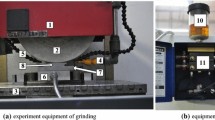Abstract
Minimum quantity lubrication (MQL) grinding using nanofluid showed superior grinding performance by reducing the grinding force and surface roughness in comparison with that of pure base fluid MQL grinding. In this study, the conditions of the grinding interaction between the grinding wheel and the workpiece were simulated by a pin-on-flat tribotester. The role of nanofluid in MQL grinding process was investigated through friction and wear experiments. The results show that nanoparticles, especially Al2O3, added to base fluid exhibit noticeable friction reduction and anti-wear properties. The addition of Al2O3 nanoparticles in deionized water decreased the friction coefficient and the worn weight by 34.2 and 43.4 %, respectively, as compared to the pure deionized water. Furthermore, investigation was performed using scanning electron microscopy and surface profilometer to interpret the possible mechanisms of friction reduction and anti-wear with nanoparticles.
Similar content being viewed by others

References
Malkin S, Guo C (2008) Grinding technology: theory and application of machining with abrasives. Industrial, New York
Ding WF, Xu JH, Chen ZZ, Su HH, Fu YC (2011) Grain wear of brazed polycrystalline CBN abrasive tools during constant-force grinding Ti-6Al-4V alloy. Int J Adv Manuf Technol 52:969–976
Brinksmeier E, Heinzel C, Wittmann M (1999) Friction cooling and lubrication in grinding. Annals of the CIRP 48(2):581–598
Tasdelen B, Wikblom T, Ekered S (2008) Studies on minimum quantity lubrication (MQL) and air cooling at drilling. J Mater Process Technol 200:339–346
Liao YS, Lin HM (2007) Mechanism of minimum quantity lubrication in high-speed milling of hardened steel. International Journal of Machine Tools & Manufacture 47:1660–1666
Khan MMA, Mithu MAH, Dhar NR (2009) Effects of minimum quantity lubrication on turning AISI 9310 alloy steel using vegetable oil-based cutting fluid. J Mater Process Technol 209:5573–5583
Barczak LM, Batako ADL, Morgan MN (2010) A study of plane surface grinding under minimum quantity lubrication (MQL) condition. International Journal of Machine Tools & Manufacture 50:977–985
Sanchez JA, Pombo I, Alberdi R, Izquierdo B, Ortega N, Plaza S, Toledano JM (2010) Machining evaluation of a hybid MQL-CO2 grinding technology. J Clean Prod 18:1840–1849
Tawakoli T, Hadad MJ, Sadeghi MH (2010) Influence of oil mist parameters on minimum quantity lubrication-MQL grinding process. Int J Mach Tool Manuf 50:521–531
Shen B, Shih AJ, Tung SC (2008) Application of nanofluids in minimum quantity lubrication grinding. Tribol Trans 51:730–737
Shen B, Malshe AP, Kalita P, Shih AJ (2008) Performance of novel MoS2 nanoparticles based grinding fluids in minimum quantity lubrication grinding. Transactions of NAMRI/SME 36:357–364
Sridharan U, Malkin S (2009) Effect of minimum quantity lubrication (MQL) with nanofluid on grinding behavior and thermal distortion. Transactions of NAMRI/SME 37:629–636
Lee P, Nam TS, Li C, Lee SW (2010) Environmentally-friendly nano-fluid minimum quantity lubrication (MQL) meso-scale grinding process using nano-diamond particles. In: Proceedings of the International Conference on Manufacturing Automation, Hong Kong, pp 44–49
Kalita P, Malshe AP, Kamlakar P, Rajurkar P (2012) Study of tribo-chemical lubricant film formation during application of nanolubricants in minimum quantity lubrication (MQL) grinding. Annals of the CIRP 61:327–330
Shen NF, Zhang DJ, Li ZD (2003) New handbook of metallic materials. Science, Beijing
Mao C, Zou HF, Huang XM, Zhang J, Zhou ZX (2013) The influence of spraying parameters on grinding performance for nanofluid minimum quantity lubrication. Int J Adv Manuf Technol 64:1791–1799
Wen SZ, Huang P (2008) Priciples of tribology. Tsinghua University Press, Beijing
Schwartz CJ, Bahadur S (2000) Studies on the tribological behavior and transfer film-counterface bond strength for polyphenylene sulfide filled with nanoscale alumina particles. Wear 237:261–273
Xu T, Zhao JZ, Xu K (1996) The ball-bearing effect of diamond nanoparticles as an oil additive. J Phys D Appl Phys 29:2932–2937
Wu YY, Tsui WC, Liu TC (2007) Experimental analysis of tribological properties of lubricating oil with nanoparticle additives. Wear 262:819–825
Kalita P, Malshe AP, Kumar SA, Yoganath VG, Gurumurthy T (2012) Study of specific energy and friction coefficient in minimum quantity lubrication grinding using oil-based nanolubricants. J Manuf Process 14:160–166
Ingole S, Charanpahari A, Kakade A, Umare SS, Bhatt DV, Menghani J (2013) Tribological behavior of nano TiO2 as an additive in base oil. Wear 301:776–785
Shao X, Liu W, Xue Q (2004) The tribological behavior of micrometer and nanometer TiO2 particle-filled poly (phthalazine ether sulfone ketone) composites. J Appl Polym Sci 92:906–914
Author information
Authors and Affiliations
Corresponding author
Rights and permissions
About this article
Cite this article
Mao, C., Huang, Y., Zhou, X. et al. The tribological properties of nanofluid used in minimum quantity lubrication grinding. Int J Adv Manuf Technol 71, 1221–1228 (2014). https://doi.org/10.1007/s00170-013-5576-7
Received:
Accepted:
Published:
Issue Date:
DOI: https://doi.org/10.1007/s00170-013-5576-7



